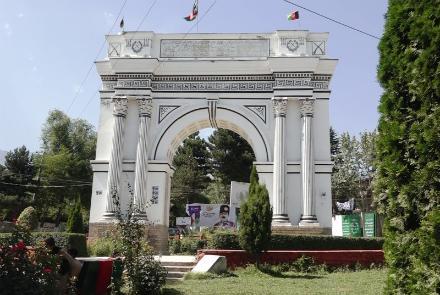The 100th anniversary of Afghanistan’s independence from Britain was marked on Aug. 19, remembering the day King Amanullah Khan proclaimed independence after his heroic victory in the Third Anglo-Afghan War. Independence for Afghanistan meant the complete freedom of its foreign affairs from British control. Thus, Afghanistan was never a British colony as such.
As Afghans were preparing to celebrate the anniversary with great pomp and show, a wedding ceremony in the west of Kabul was attacked by a suicide bomber affiliated with Daesh, killing 80 and injuring about 170. The entire nation was confused about whether to celebrate Independence Day or mourn the death of innocent civilians. The sheer brutality and magnitude of this horrific incident shows how vulnerable the country is to terrorist attacks, anywhere and at any time.
As Afghanistan completes 100 years since its independence, its people are looking back at what their country has been through during the past century. Throughout the last 40 years, Afghanistan has remained in conflict, starting with the communist coup of 1978 that paved the way for the Soviet invasion in 1979. These events were significant, as they led to all the other misfortunes that Afghanistan has since faced. The previous 60 years of Afghanistan’s history were characterized by political instability and an evolving monarchy, although the country remained largely peaceful. However, poverty has remained the hallmark of Afghan society ever since its independence. The country has never witnessed an era of prosperity despite abundant natural wealth.
Amanullah, the freedom hero, wanted to modernize Afghanistan. He was a reformist and against the age-old traditions. When he embarked on his ambitious agenda for social change, including the empowerment of women, he was resisted by conservative elements of society and was ultimately overthrown following an uprising led by Habibullah Kalakani (well known as Bach-i-Saqaw, meaning son of the water-carrier), which branded him as secular. Kalakani became king but never gained recognition in the wider Afghan society. He was removed from power and killed by a popular tribal army led by Nadir Shah, a distant cousin of Amanullah.
When Shah became the new monarch of Afghanistan, he abandoned Amanullah’s reforms and modernization agenda and instead adopted a gradual approach. After his assassination, his young son Mohammed Zahir Shah sat on the throne, while the government was virtually run by his two uncles, Mohammed Hashim Khan and Shah Mahmud Khan, who served as prime ministers. In 1952, King Zahir’s cousin Daud Khan was appointed as prime minister. Khan was a die-hard nationalist and also a modernizer but, unlike Amanullah, who wanted a quick change, he favored gradual reforms. He remained in power until the 1964 constitution required that the prime minister be outside of the royal family. In 1973, Khan seized power in a bloodless coup, abolished the monarchy and became president. He ruled for five years before being toppled by a communist coup and the People’s Democratic Party of Afghanistan (PDPA) came to power.
The PDPA had the strong support of the former Soviet Union and, in 1979, the latter invaded Afghanistan and millions of Afghans migrated to neighboring Pakistan and Iran. The Soviet invasion of Afghanistan triggered strong reactions from the Western and Islamic worlds, which supported the Afghans in their freedom struggle against the Soviet occupation. The US was the main source of political, military and logistical support for the Afghan resistance. At the cost of about 1.5 million Afghan lives, the Soviet Union was defeated and its occupation ended in 1989, while the last communist ruler, Mohammed Najibullah, was ousted in 1992.
The mujahideen came to power with promises of a stable and prosperous Afghanistan, yet they got involved in a bloody civil war that caused the deaths of thousands. The country was in total anarchy because of warlords that fought among themselves for power. In the wake of the mujahideen’s anarchic rule, the Taliban emerged in Kandahar. They soon spread their writ to the rest of the country and brought relative stability. However, due to their extremely radical rule, they alienated the majority of Afghans and did not get recognition from the international community. They also hosted Osama bin Laden, the Al-Qaeda leader who was behind the Sept. 11, 2001, attacks in the US.
The Taliban regime was overthrown by a US-led invasion in Dec. 2001 and a new era of democracy began, with Hamid Karzai as the interim president. After winning the 2004 election, Karzai became the first democratically elected president of Afghanistan. In 2014, Ashraf Ghani came to power through a democratic and peaceful transfer of power. Despite the fact that the past 17 years of democratic rule have provided many dividends in terms of development and rehabilitation, foreign aid has not been effectively utilized. About $100 billion have been poured into the country and, with better governance, these financial resources could have had a much greater impact.
The past 100 years of Afghan history, and particularly the events of the last four decades, are directly responsible for the ongoing situation, which is characterized by a lack of peace and security, coupled with political and economic instability. The majority of Afghans believe the communist coup of 1978 that toppled Khan’s government was the root cause of all the foreign interventions that eventually led to the emergence of the Taliban and other extremist groups.
Despite all the gains in development and democracy, the Taliban insurgency continues to threaten the Afghan state, hampering efforts for development and prosperity. The ongoing efforts for peace have raised hopes for a political settlement to end the conflict that has lasted for the past four decades. If peace returns to the country, the true meaning of independence will be realized and Amanullah’s dream of a modern and developed Afghanistan will come true.
Ajmal Shams, based in Kabul, is president of the Afghanistan Social Democratic Party. He was a deputy minister in the national unity government and served as policy adviser to President Ashraf Ghani before his presidential bid. Twitter: @ajmshams


Comment this post